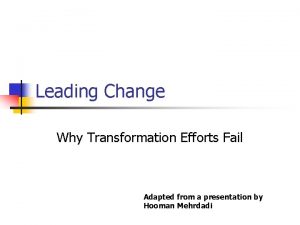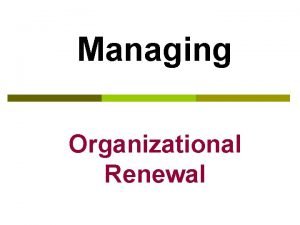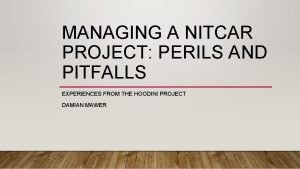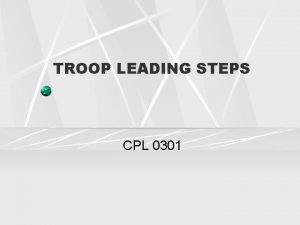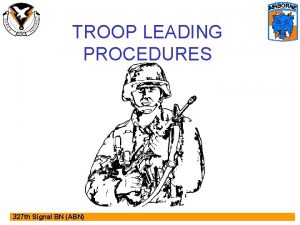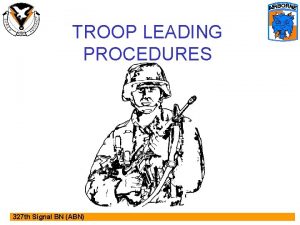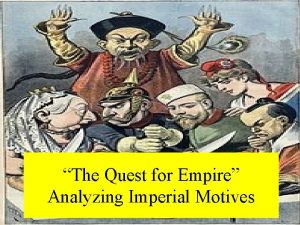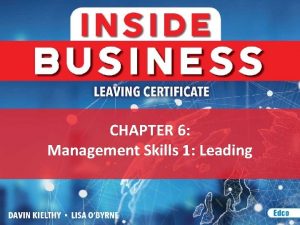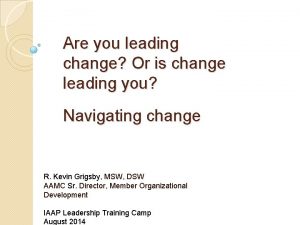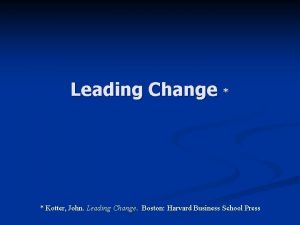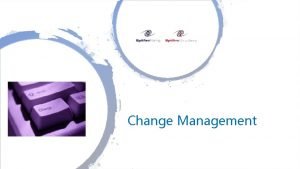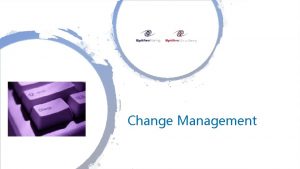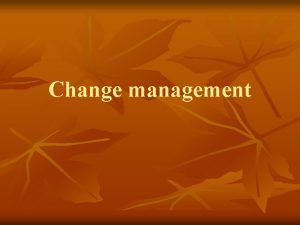Leading Change Change Management N O E L














- Slides: 14

Leading Change & Change Management N O E L H I R S T, A S S I S T A N T V I C E P R E S I D E N, T B U S I N E S S A F F A I R S F I N A N C EA N D FACILITIES M A R G A R E T D Y E R- C H A M B E R L A, I N A S S O C I A T E V I C E P R O V O S TF O R A D M I N I S T R A T , I O N S T U D E N T A F F A I R S 1

Agenda Introduction – a little bit about us Change Management – Information and Observations Two Change Management Stories Resources Questions and Answers 2

Change - What is one word you use to describe change? “It's not so much that we're afraid of change or so in love with the old ways, but it's that place in between that we fear. . It's like being between trapezes. It's Linus when his blanket is in the dryer. There's nothing to hold on to. ” “Not everything that is faced can be changed. But nothing can be changed until it is faced. ” James Baldwin 3 Alvin Toffler Marilyn Ferguson

Change - What is / has changed for you at work or home? Ø Ø Ø Work location New leaders Alternative work locations/mobile work Flexible work schedule Addition to family or Empty Nest……………what else? Change Drivers Ø Ø Ø 4 Mission, Strategic Plan Competitive Landscape Customers/Customer needs Financial Performance Regulatory Issues/Compliance……………what else?

Navigating Change requires Resilience What is Resilience? Ø Cope Ø Bounce Back Ø Absorb Ø Adjust Ø Maintain Components of Personal Resilience: Ø Understand yourself Ø Know the Territory Ø Connect to Resources Ø Take Action 5

Managing Through Change Value Proposition for Employee? Organization/ Manager Response? ØWhat is in it for me? ØWhat is required of me? How will you communicate with the employee(s) about these issues? . . . Resistance is normal Communication is key to assisting employees through change! Change provides both Challenges and Opportunities – what are they? Change can have multiple dimensions (Transactional or Transformational): Ø Ø Ø 6 Structural (workspace – office or cube to variable open plan) Operational (save & store hard copy files to scanning and electronic storage) Technical (participation in more virtual meetings – less face to face interactions) Cultural (one main campus to multiple work locations & work-from-home) Personal (commute changes, child care options, alternative work options)

Moving Through The Change Curve Stages of Change & Action Anticipation - know or expect change – Be flexible & Prepared Denial/Letting go – facing the facts – Handle the loss Anger/Disorientation – no longer the same – Gain perspective from others Exploring/Reappraisal – New Look, assessing options – Make a choice Acceptance/Recommitment – reconnect to sense of purpose – Move forward EBA; Kubler-Ross; Lee Hect Harrison 7

Leading Through Change – Leaders’ Actions Ø Anticipation – Communicate: Communicate case for change, communicate often, consistently, honestly, and simply. Follow-up talks Ø Denial/Letting go – Active listening: Acknowledge loss & impacts, create a safe environment for sharing and discussion Ø Anger/Disorientation – Direct: Assist employee with prioritization of tasks, short term goals, interim steps, frequent check ins Ø Exploring/Reappraisal – Engage: Reward and reinforce positive behavior, seek opportunities to solicit suggestions from individuals regarding implementation of the change, watch for regression – engage the employee right away Ø Acceptance/Recommitment – Coach: Recruit early adopters as change agents, recruit SMEs, partner early adopters with more challenged staff, share successes, highlight achievements EBA; Kubler-Ross; Lee Hect Harrison 8

Leading Through Change – Threats & Rewards Social Qualities Threats Rewards Status: Perceived relative Superior attitude, negative feedback, left out Public Acknowledgement, positive feedback, new skills that enhance standing Telling half-truths, inconsistency, job-insecurity Sharing vision, goals, expectations, how decisions will be made over events Micromanagement, command & control leadership Participating in decision-making, self-directed learning, own time management Relatedness: A sense of safety Being ignored, rejection, left out Feeling included, trusted, common goals Broken promises, unmet expectations, different rules/standards , inconsistency Timely information sharing, transparency, giving preference appropriately importance to others Certainty: Ability to predict the future Autonomy: A sense of control with others Fairness: Perception of fair exchanges between people Manager Academy, Ewins & Winby 9

Two Stories of Change Story #1 – At the personal level Story #2 – At the management level 10

Story #1 – At the personal level 11

Story #2 – At the management level 12

Resources related to Change “Leading Change, ” John P. Kotter, Harvard Business Review Press, 2012. “The Thin Book of Appreciative Inquiry, ” Sue Annie Hammond, Thin Book Publishing Company, 2013. “Managing Transitions: Making the Most of Change, ” William Bridges and Susan Bridges, De Capo Press, Perseus Book Group, 2016. “Managing with the Brain in Mind, ” David Rock, Strategy+Business, Issue 56, Autumn 2009. “HBR’s 10 Must Reads on Change Management, ” John Kotter, W. Chan & Renee A. Mauborne, Harvard Business Review Press, 2011. “Organization Change: Theory and Practice, ” Warner Burke, SAGE Publications, 2018. 13

Questions, Answers, Discussion Our contact information: Noel Hirst, nhirst@Stanford. edu Margaret Dyer-Chamberlain, mdyerc@Stanford. edu 14
 Objectives of roving frame
Objectives of roving frame Kotter why transformation efforts fail
Kotter why transformation efforts fail Leading change and organizational renewal
Leading change and organizational renewal Leading change and organizational renewal
Leading change and organizational renewal The perils and pitfalls of leading change case solution
The perils and pitfalls of leading change case solution Leading through change presentation
Leading through change presentation Positive leading coefficient graph
Positive leading coefficient graph Leading coefficient test
Leading coefficient test Liberty leading the people, 1830
Liberty leading the people, 1830 Troop leading procedures
Troop leading procedures Tlp army
Tlp army 8 troop leading procedures
8 troop leading procedures Leading motives quest
Leading motives quest Leading motives quest
Leading motives quest Planning, organizing, staffing, directing and controlling
Planning, organizing, staffing, directing and controlling

